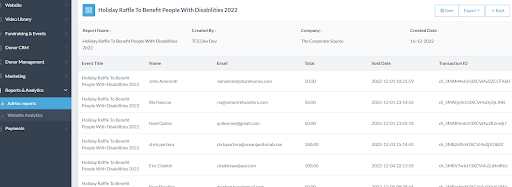
How to Start and Run a Successful Nonprofit - A Complete Guide
Starting and running a successful nonprofit organization can be a rewarding and fulfilling experience. However, it requires a lot of hard work, dedication, and commitment. In this guide, we will discuss the steps involved in starting and running a successful nonprofit organization.
What is Nonprofit Organization?
A nonprofit organization is a type of organization that is dedicated to promoting a specific social cause or goal, rather than generating profits for its owners or shareholders. Nonprofit organizations are also known as not-for-profit organizations, charities, or NGOs (non-governmental organizations).
Nonprofit organizations can take many forms, including charities, educational institutions, religious organizations, advocacy groups, social welfare organizations, and more. These organizations are typically funded by donations, grants, and other forms of fundraising, rather than by profits generated from commercial activities.
Nonprofit organizations are often subject to specific legal and regulatory requirements, which can vary by jurisdiction. These requirements are designed to ensure that the organization operates in a transparent and accountable manner and that its resources are used to further its stated mission or goals.
How to Start and Run a Successful Nonprofit - A Complete Guide
Step 1: Identify Your Mission and Vision

The first step in starting a successful nonprofit organization is to identify your mission and vision. You need to have a clear understanding of what your organization aims to achieve and how it plans to achieve it. Your mission and vision statement should be concise, compelling, and easy to understand.
Here are some steps to help you identify your mission and vision for your nonprofit:
1.1. Define your values:
Start by listing your organization's core values. What do you stand for? What are the principles that guide your work?
1.2. Conduct a SWOT analysis:
Identify your organization's strengths, weaknesses, opportunities, and threats. This will help you better understand your organization's position and identify areas where you need to focus.
1.3. Define your target audience:
Who do you serve? What are their needs, challenges, and aspirations? Understanding your audience is critical in defining your mission and vision.
1.4. Brainstorm your mission statement:
Your mission statement should be clear, concise, and compelling. It should communicate your organization's purpose and the impact you hope to make.
1.5. Envision your ideal future:
Your vision statement should describe the future you hope to achieve. It should be ambitious, inspiring, and aspirational.
Step 2: Conduct Research
Once you have identified your mission and vision, you need to conduct research to determine the feasibility of your nonprofit idea. You should research the needs of the community you plan to serve, the existing nonprofit organizations that are already serving that community, and the resources that are available to you.

Here are some steps to help you identify your mission and vision for your nonprofit:
2.1. Define your values:
Start by listing your organization's core values. What do you stand for? What are the principles that guide your work?
2.2. Conduct a SWOT analysis:
Identify your organization's strengths, weaknesses, opportunities, and threats. This will help you better understand your organization's position and identify areas where you need to focus.
2.3. Define your target audience:
Who do you serve? What are their needs, challenges, and aspirations? Understanding your audience is critical in defining your mission and vision.
2.4. Brainstorm your mission statement:
Your mission statement should be clear, concise, and compelling. It should communicate your organization's purpose and the impact you hope to make.
2.5. Envision your ideal future:
Your vision statement should describe the future you hope to achieve. It should be ambitious, inspiring, and aspirational.
Step 3: Develop a Business Plan
A business plan is an essential tool for any nonprofit organization. It outlines your organization's goals, strategies, and operations. A business plan should include a description of your organization, your mission and vision statement, your target audience, your fundraising strategies, and your budget.

Here are the steps to follow:
3.1. Executive Summary:
Begin with an executive summary that outlines the purpose of the nonprofit, its mission, and its goals.
3.2. Overview of the Organization:
Provide an overview of the organization, including its history, current status, and structure.
3.3. Market Analysis:
Conduct a market analysis to identify the target audience and the need for the services the nonprofit provides. This should also include an assessment of competitors and potential partners.
3.4. Programs and Services:
Describe the programs and services the nonprofit offers, along with the impact they have on the community. This should include any current or planned activities, and how they align with the organization's mission.
3.5. Marketing and Communications:
Develop a marketing and communication plan that outlines how the nonprofit will promote its programs and services to its target audience.
Step 4: Form a Board of Directors
Your board of directors will play a critical role in the success of your nonprofit organization. They will provide guidance, support, and oversight. You should look for individuals who are passionate about your mission, have experience in nonprofit management, and have a strong network.

Here are the steps to follow:
4.1. Determine the board size:
Determine the appropriate size for your board of directors. This can vary depending on the size and complexity of your organization, but a common range is 5-15 members.
4.2. Identify the needed skills and expertise:
Identify the skills and expertise your organization needs on the board, such as financial management, legal expertise, fundraising experience, or industry-specific knowledge.
4.3. Recruit board members:
Reach out to potential board members who have the necessary skills and expertise. This could include community leaders, volunteers, or individuals with a passion for your mission. Ensure that the prospective members understand the responsibilities and time commitment required.
4.4. Conduct interviews and background checks:
Interview potential board members and conduct background checks to ensure they have no conflicts of interest or legal issues that could impact their ability to serve on the board.
4.5. Orient new members:
Provide new board members with an orientation that includes an overview of the organization, its mission, bylaws, and any policies or procedures. This will ensure they understand their roles and responsibilities as board members.
Step 5: Register Your Nonprofit
Once you have developed your business plan and formed your board of directors, you need to register your nonprofit organization. You will need to choose a name for your organization, file articles of incorporation, and apply for tax-exempt status with the IRS.
Here are 5 steps that will provide a general overview of the process:
5.1. Choose a name for your nonprofit:
Choose a name that reflects your organization's mission and goals. Ensure that the name is not already in use by another nonprofit in your state.
5.2. Determine the legal structure:
Choose a legal structure that best suits your organization's needs. The most common types of legal structures for nonprofits are a 501(c)(3) or a 501(c)(4).
5.3. Develop bylaws:
Bylaws are the rules and procedures that govern your nonprofit organization. They should outline the organization's purpose, board of directors, membership, and other important details.
5.4. Incorporate your nonprofit:
File articles of incorporation with your state's Secretary of State office. This step creates a legal entity that is separate from its members and provides protection from personal liability.
5.5. Obtain tax-exempt status:
File for tax-exempt status with the Internal Revenue Service (IRS) using Form 1023 or Form 1024, depending on your organization's structure. This step allows your organization to receive tax-deductible donations and avoid paying federal income taxes.
Step 6: Build Your Team
Your nonprofit organization will need a team of dedicated and passionate individuals to help you achieve your mission. You should recruit volunteers, staff, and contractors who share your vision and are committed to your cause.

Here are some steps you can take to build your team:
6.1. Identify the roles you need:
Start by identifying the specific roles you need to fill within your organization, such as a director, program coordinator, fundraiser, volunteer coordinator, etc.
6.2. Create job descriptions:
Once you have identified the roles, create clear job descriptions that outline the responsibilities and requirements of each position.
6.3. Define your organizational culture:
Consider the values, mission, and vision of your organization and use these to define your organizational culture. This will help you identify the type of people who will be a good fit for your team.
6.4. Recruit volunteers:
Reach out to your network, post on social media and job boards, and attend local events to recruit volunteers who are passionate about your cause.
6.5. Conduct interviews:
Interview potential candidates to assess their skills, experience, and fit with your organizational culture. Be sure to ask questions that reveal their commitment to your cause and their ability to work effectively as part of a team.
Step 7: Develop Fundraising Strategies
Fundraising is a critical component of any nonprofit organization. You need to develop fundraising strategies that will help you raise the necessary funds to achieve your mission. You can use a variety of fundraising techniques, such as grant writing, corporate partnerships, individual donations, and special events.
Here are some steps to consider when developing fundraising strategies:
7.1. Define your goals and target audience:
Before you can begin developing fundraising strategies, it's important to define your organization's goals and determine your target audience. Your fundraising strategies should align with your organization's mission and vision.
7.2. Develop a case for support:
A case for support is a document that outlines your organization's mission, goals, and fundraising needs. This document should be compelling and demonstrate the impact of your organization's work.
7.3. Identify fundraising methods:
There are many fundraising methods, including grant writing, individual donations, special events, corporate partnerships, and crowdfunding. Consider which methods will work best for your organization and develop a plan to implement them.
7.4. Set fundraising targets:
Determine how much money your organization needs to raise and set fundraising targets for each method. Make sure your targets are realistic and achievable.
7.5. Develop a fundraising calendar:
Create a calendar that outlines your fundraising activities throughout the year. This should include deadlines for grant applications, event planning, donor outreach, and other fundraising activities.
By following these steps, you can establish a strong online presence for your nonprofit, engage with your supporters, and make a meaningful impact.
Head over to missio.io to create your account and sign up with Stripe, our payment processor, and you’ll be up and running in under an hour, ready to start taking in donations.
Here’s how a nonprofit used Missio to run their Fundraising campaign and get donations with a simple yet well-branded page, optimized for desktop and mobile.
Step 8: Establish a Strong Online Presence
In today's digital age, having a strong online presence is essential for any nonprofit organization. You should create a website, social media accounts, and email marketing campaigns to help you reach your target audience and communicate your message effectively.
Here are some steps you can take to establish a strong online presence for your nonprofit:
8.1. Develop a website:
A website is the foundation of your online presence. Make sure your website is user-friendly, visually appealing, and easy to navigate. It should also clearly communicate your nonprofit’s mission, goals, and impact.
8.2. Use social media:
Social media is an excellent tool to engage with your supporters and promote your organization’s activities. Create profiles on social media platforms like Facebook, Twitter, Instagram, and LinkedIn, and post regular updates about your nonprofit’s activities.
8.3. Create valuable content:
Create blog posts, videos, and other content that aligns with your nonprofit’s mission and values. This will not only help you engage with your supporters but also help establish your organization as a thought leader in your field.
8.4. Build an email list:
Email marketing is an effective way to stay in touch with your supporters and keep them updated about your organization’s activities. Build an email list and send regular newsletters and updates.
8.5. Leverage online fundraising tools:
Online fundraising tools like crowdfunding platforms, peer-to-peer fundraising, and donation buttons on your website can help you raise funds more effectively.
Monitor and analyze your online presence: Keep track of your website traffic, social media engagement, and other online metrics to understand what works and what doesn’t. Use this information to refine your online presence and improve your outreach.
Here are a few of our top picks:
Nonprofit Software – Missio
Email Software – Missio
CRM – Missio
Analytics – Google Analytics, Missio Analytics
Social Media Management – Buffer
Design – Canva
Task Management – Missio
Website Development - Networkhandlers
Digital Marketing - Networkhandlers
Step 9: Monitor and Evaluate Your Progress
Once your nonprofit organization is up and running, you need to monitor and evaluate your progress regularly. You should track your fundraising efforts, measure the impact of your programs, and analyze your financial statements.

Here are some steps you can take to monitor and evaluate your progress:
9.1. Define your goals and objectives:
Clearly define what your nonprofit organization hopes to achieve and establish specific, measurable, achievable, relevant, and time-bound (SMART) goals.
9.2. Set up monitoring systems:
Establish monitoring systems to track progress towards achieving your goals. This could involve collecting data, conducting surveys, and measuring outcomes.
9.3. Analyze data:
Regularly review the data you collect to evaluate progress towards your goals. Identify any trends or patterns and determine whether you are making progress towards achieving your objectives.
9.4. Adjust your approach:
Based on your analysis, determine if your approach needs to be adjusted to achieve your goals more effectively. This could involve making changes to your programs or services, refining your messaging, or reallocating resources.
9.5. Engage stakeholders:
Engage with stakeholders, including donors, volunteers, and community members, to gather feedback on your progress and identify areas for improvement.
Step 10: Stay Committed to Your Mission
Finally, you need to stay committed to your mission. Starting and running a successful nonprofit organization takes time, patience, and dedication. You need to be willing to work hard, overcome challenges, and stay focused on your goals.
Here are some tips to help you stay focused and committed to your mission:
10.1. Clarify your mission:
Make sure that your mission is clear, specific, and measurable. Ensure that everyone in your organization understands and is committed to it.
10.2. Set goals and objectives:
Break down your mission into specific goals and objectives, and create a plan to achieve them. Set deadlines and track your progress.
10.3. Develop a strategic plan:
Develop a long-term strategic plan that aligns with your mission and outlines the steps you need to take to achieve your goals.
10.4. Engage your team:
Involve your team in the mission of your organization. Encourage them to share their ideas and suggestions, and ensure that everyone understands their role in achieving the organization's goals.
10.5. Celebrate your successes:
Celebrate your successes along the way. Acknowledge the hard work of your team and the progress you've made toward your goals.
Nonprofit organizations are an essential part of society, serving to address various social, environmental, and humanitarian causes. However, running a nonprofit is not an easy feat, and it requires dedication, commitment, and careful planning. By following these tips, you can build a successful nonprofit organization that makes a positive impact in your community and beyond.
Missio offers a comprehensive range of products designed to help your nonprofit operate smoothly, regardless of your location. Our suite includes a set of integrated products that work together seamlessly, freeing you from software-related worries and enabling you to concentrate on your organization's mission. Missio is more than just a platform – it's the perfect tool to accelerate the spread of your mission.
Also, be sure to visit our Nonprofit Blog for a wealth of additional free resources.







0 COMMENTS
Please log in to post a comment.